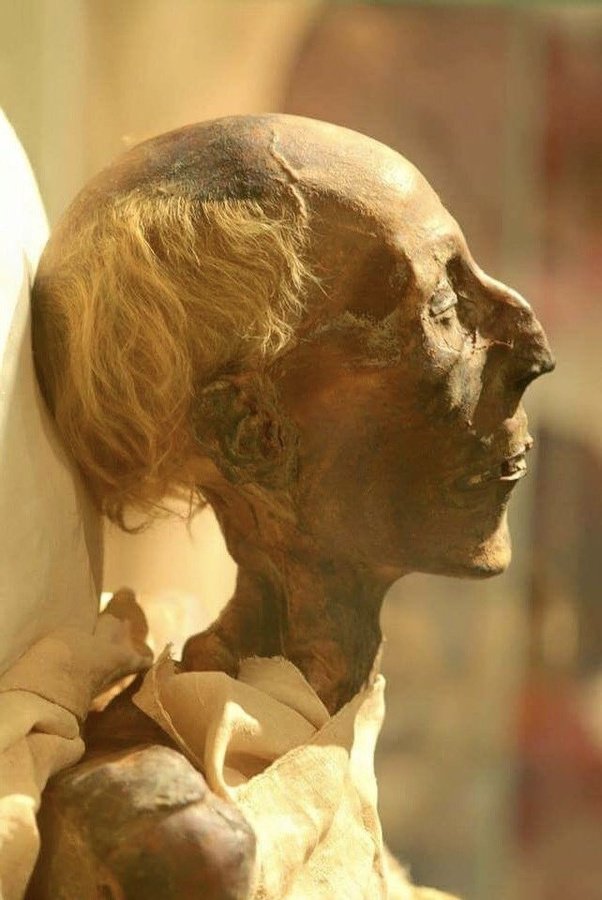The mummy of Thuya is one of ancient Egypt’s most fascinating and well-preserved artifacts. As the mother of Queen Tiye, the grandmother of Pharaoh Akhenaten, and the great-grandmother of the young pharaoh Tutankhamun, Thuya occupies a vital position in Egyptian history, tying together a lineage of legendary rulers and powerful queens. Her prominent titles and probable connections to even earlier royal figures paint a picture of a woman with deep religious influence and high status within Egypt’s 18th Dynasty.
Thuya’s Lineage and Royal Legacy
Origins and Possible Ties to Queen Ahmose-Nefertari
Thuya, who lived during the 14th century BCE, may be linked to the legendary Queen Ahmose-Nefertari, wife of Pharaoh Ahmose I. Queen Ahmose-Nefertari was an essential figure in the foundation of the 18th Dynasty and served as the first “God’s Wife of Amun,” a title that denoted both spiritual significance and political power. If Thuya was indeed descended from this influential queen, her family lineage would emphasize her importance within the royal family and the religious landscape of the time.
Family Ties to the Amarna Period
Thuya’s children included Queen Tiye, who became the Great Royal Wife of Pharaoh Amenhotep III. Tiye’s marriage to Amenhotep III, and her resulting influence on his reign, was a pivotal factor in the Amarna period’s religious and cultural shifts. The lineage also connects Thuya to her grandson, Akhenaten, a pharaoh known for his monotheistic worship of Aten and for moving the capital to Amarna. This lineage is completed with her great-grandson, Tutankhamun, whose rule marked the restoration of the traditional Egyptian pantheon and beliefs.

Thuya’s Titles and Their Religious Implications
“Singer of Hathor”
One of Thuya’s esteemed titles was “Singer of Hathor,” an honor associated with the goddess Hathor, who represented joy, love, and music. As a “Singer,” Thuya would have participated in important ceremonies and music rituals honoring Hathor. This role was more than ceremonial; Hathor’s worship held deep cultural significance, and “Singers of Hathor” were considered central figures in rituals that reinforced societal values of harmony, beauty, and protection.
“Chief of the Animers of Amun and Min”
Thuya also held the influential title of “Chief of the Animers” for both Amun, the god of the sun and creation, and Min, the god of fertility and harvest. Animers, or temple dancers, were integral to religious ceremonies, and as their chief, Thuya would have overseen key aspects of worship. This role not only highlights her high status but also demonstrates her direct involvement in rituals that connected the ruling family to the divine.
The title also suggests a strong alignment with the Amun priesthood, a powerful institution in Egyptian society. This connection is especially relevant, as it foreshadows the later religious turmoil under Akhenaten, who moved away from the Amun cult in favor of Aten worship.
The Mummy of Thuya: Discovery and Preservation
Discovery of Thuya’s Tomb
Thuya’s mummy, along with that of her husband, Yuya, was discovered in 1905 in KV46, a well-preserved tomb in the Valley of the Kings. Their tomb is notable for containing numerous items of personal belongings, amulets, and intricate funerary artifacts that reflect the status and wealth they held. The tomb itself, predating Tutankhamun’s, was one of the most intact finds in the Valley of the Kings, yielding a wealth of information about burial customs, embalming techniques, and luxury items of the era.
The Mummy’s Condition and Significance
The mummy of Thuya is exceptionally well-preserved, with her facial features and hair still largely intact. This remarkable preservation has allowed Egyptologists to closely study her physical attributes and clothing, providing insights into 18th Dynasty burial practices and cosmetic trends. Additionally, her mummy’s preservation underscores the ancient Egyptians’ advanced knowledge of mummification, which helped royal figures like Thuya pass into the afterlife.

The Legacy of Thuya’s Influence in Ancient Egypt
Connections to the Amun Priesthood and Religious Power
Thuya’s roles within the Amun and Min cults illustrate the central role women could play in religious life and influence during Egypt’s 18th Dynasty. As a chief priestess-like figure in these cults, Thuya wielded spiritual authority that complemented her family’s political clout. This influence passed down through her daughter, Queen Tiye, who was known to wield significant authority alongside Amenhotep III and is considered one of Egypt’s most powerful queens.
A Symbol of Continuity and Change
The mummy of Thuya serves as a symbol of both continuity and change within Egypt’s dynastic history. Her life bridged the traditional religious practices of Thebes with the dramatic religious upheaval brought on by her grandson, Akhenaten. Her preserved titles and mummy tell a story of the powerful role that royal women could occupy in the spiritual, cultural, and political spheres of ancient Egypt.
Conclusion: Thuya’s Enduring Legacy
The mummy of Thuya is more than an artifact; it represents a link to an era of political stability, spiritual reverence, and dynastic intrigue in ancient Egypt. From her titles as “Singer of Hathor” and “Chief of the Animers” to her familial connections, Thuya’s life reflects a blend of religious duty, high status, and maternal influence that helped shape Egypt’s golden age. Her story endures not only in her well-preserved mummy but in the legacy of her descendants, who reshaped Egypt’s religious and cultural landscape for generations to come.


